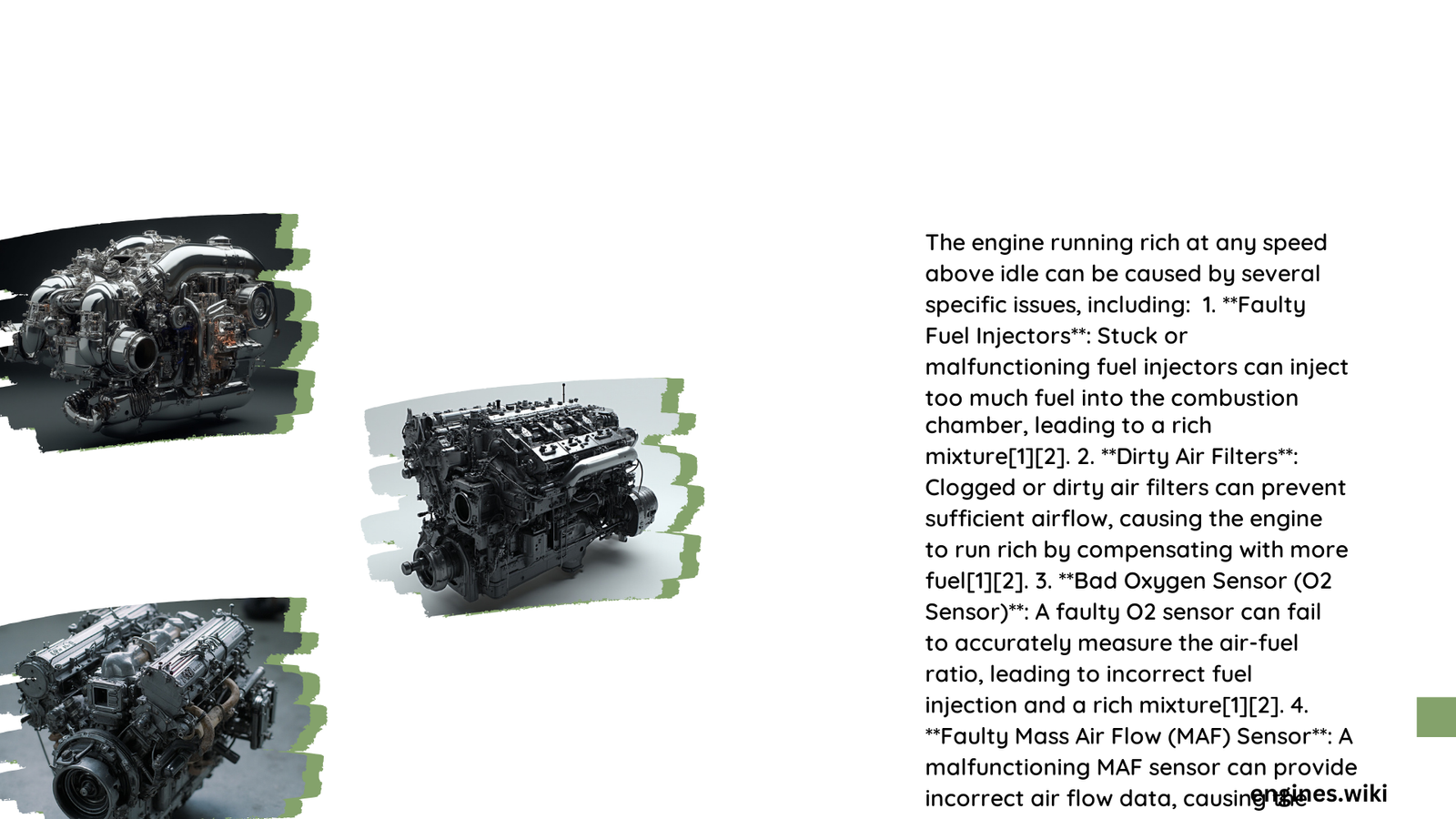An engine running rich at speeds above idle is a common issue that can lead to decreased performance, reduced fuel efficiency, and increased emissions. This problem occurs when the air-fuel mixture in the combustion chamber contains too much fuel relative to the amount of air. Several factors can contribute to this condition, including fuel injection issues, air-fuel mixture imbalances, faulty oxygen sensors, and vacuum leaks. Understanding these causes is crucial for proper diagnosis and resolution of the problem.
What Are the Main Fuel Injection Issues That Can Cause a Rich-Running Engine?
Fuel injection problems are a primary culprit in causing an engine to run rich at higher speeds. These issues can manifest in various ways:
How Do Malfunctioning Fuel Injectors Contribute to a Rich Condition?
- Clogged or Dirty Injectors: Over time, fuel injectors can become clogged with debris or fuel residue, leading to:
- Irregular spray patterns
- Increased fuel flow
-
Inconsistent fuel delivery
-
Leaking or Stuck Open Injectors: When injectors fail to close properly, they can cause:
- Continuous fuel spray into the combustion chamber
- Excessive fuel delivery at all engine speeds
- Significant imbalance in the air-fuel mixture
What Are the Typical Flow Rates for Fuel Injectors?
Fuel injector flow rates are typically measured in:
– Pounds per hour (lb/hr)
– Cubic centimeters per minute (cc/min)
For example, a common flow rate might be 24 lb/hr for a standard automotive injector.
How Can You Diagnose Faulty Fuel Injectors?
To diagnose faulty fuel injectors:
- Perform a resistance test using a multimeter
- Measure across the injector terminals
- Compare the reading to manufacturer specifications
- Typical resistance values range from 10 to 18 ohms
What Causes Air-Fuel Mixture Imbalances?

Air-fuel mixture imbalances are another significant factor in causing an engine to run rich at higher speeds.
What Is the Ideal Air-Fuel Ratio?
The ideal air-fuel ratio for most gasoline engines is:
– 14.7 parts air to 1 part fuel
– Known as the stoichiometric ratio
How Does Excess Fuel Delivery Affect Engine Performance?
Excess fuel delivery can occur due to:
1. Faulty Mass Airflow (MAF) sensor
2. Malfunctioning Oxygen (O2) sensor
3. Incorrect fuel pressure
These issues can cause the Engine Control Unit (ECU) to miscalculate the required fuel amount, leading to:
– Overly rich fuel mixture
– Decreased fuel efficiency
– Increased emissions
What Are Common Air Intake Restrictions?
Air intake restrictions can cause the engine to run rich by reducing the amount of air entering the combustion chamber. Common restrictions include:
- Dirty air filter
- Clogged Mass Airflow (MAF) sensor
- Blocked intake ducts
These restrictions force the ECU to compensate by adding more fuel, resulting in a rich mixture.
How Do Faulty Oxygen Sensors Contribute to a Rich-Running Engine?
Oxygen sensors play a crucial role in maintaining the correct air-fuel mixture. Faulty sensors can significantly impact engine performance.
What Are the Different Types of Oxygen Sensors?
- Narrowband Oxygen Sensors:
- Provide voltage output indicating rich or lean exhaust gases
- Voltage range: 0 to 1 volt
-
0.45 volts indicates stoichiometric mixture
-
Wideband Oxygen Sensors:
- Offer more precise air-fuel ratio measurements
- Used in performance tuning
- Indicate exact lambda value (air-fuel ratio)
How Do Faulty Oxygen Sensors Affect the Air-Fuel Mixture?
A malfunctioning oxygen sensor can:
1. Inaccurately report oxygen levels in the exhaust
2. Cause the ECU to supply excess fuel
3. Result in a consistently rich-running engine, especially at higher RPMs
What Are the Common Sources of Vacuum Leaks?
Vacuum leaks can introduce unmetered air into the engine, causing it to run rich as the ECU compensates with additional fuel.
Where Are Vacuum Leaks Most Likely to Occur?
Common sources of vacuum leaks include:
- Intake manifold gaskets
- Throttle body and intake ducts
- Vacuum hoses and connections
How Do Vacuum Leaks Impact Engine Performance?
Vacuum leaks can lead to:
– Decreased fuel efficiency
– Increased emissions
– Poor engine performance
– Sluggish acceleration
– Reduced power output
What Are Effective Methods for Detecting Vacuum Leaks?
- Smoke Test:
- Introduce smoke into the intake system
- Observe where smoke escapes
-
Helps identify leaks in intake manifold, throttle body, and vacuum hoses
-
Vacuum Gauge Test:
- Measure vacuum pressure in the intake system
- Normal readings: 15 to 20 inches of mercury (inHg) at idle
- Fluctuations or low readings indicate potential leaks
By understanding these various factors that can cause an engine to run rich at speeds above idle, you can more effectively diagnose and address the issue, ensuring optimal engine performance and efficiency.
